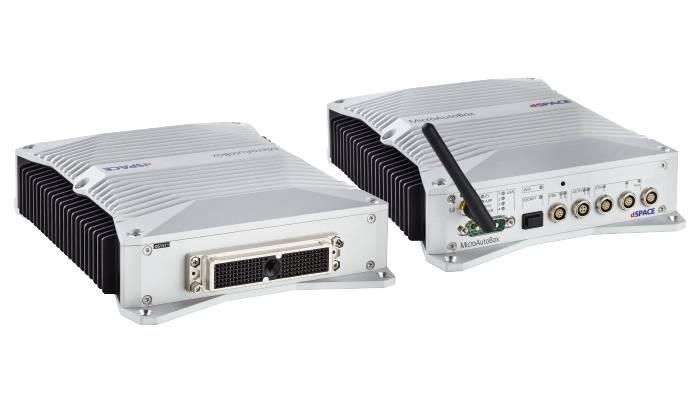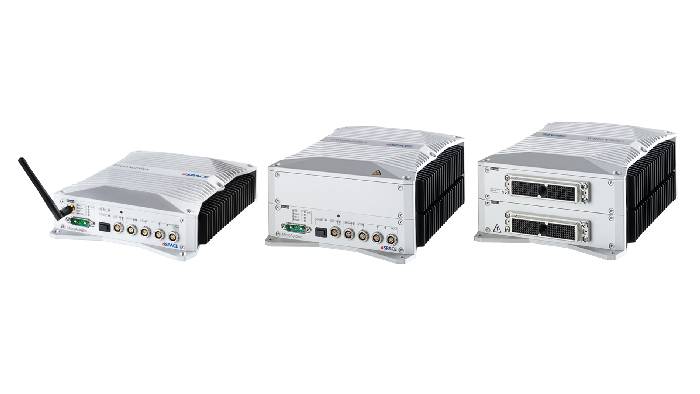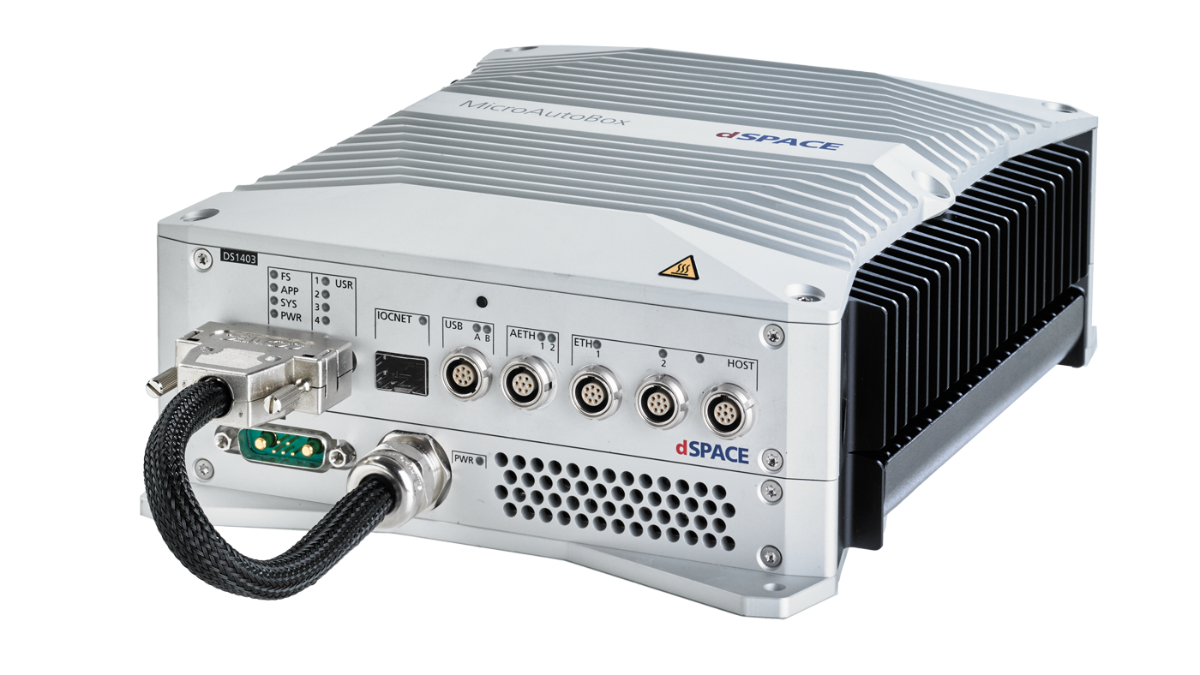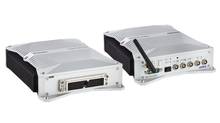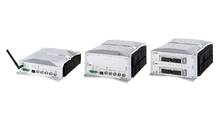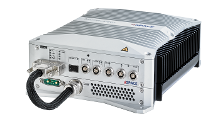MicroAutoBox III
Compact and robust in-vehicle prototyping system
The MicroAutoBox III is the next generation of the established dSPACE MicroAutoBox, a real-time system for performing fast in-vehicle function prototyping.
-
Smart New Copilot
From autonomous driving to zero emissions – for the in-vehicle prototyping of the future, dSPACE is now launching the new MicroAutoBox III, the next, much more powerful, generation of the industry-proven MicroAutoBox product family. The MicroAutoBox III is a state-of-the-art development system for future applications that can turn ideas into real vehicle functions right away.
Read more
-
Perfectly Connected
A new DS1521 Bus and Network Board integrated in the MicroAutoBox III provides an exceptional range of channels in the familiar small MicroAutoBox form factor.
- High computation power with quad-core ARM® processor
- Comprehensive bus and network support, including CAN, CAN FD, LIN, FlexRay, and (automotive) Ethernet
- Functional safety monitoring features1)
Application Areas
The powerful system can be added to or replace an electronic control unit (ECU), and lets you experience and test control functionalities in a real environment. MicroAutoBox III is ideal for many different rapid control prototyping (RCP) applications from autonomous driving to zero emissions either as a single demonstrator or for equipping entire test fleets. Examples of application fields are:
- E-mobility, electrification, and powertrain control
- Assisted, highly automated, and autonomous driving
- Chassis, body, and vehicle dynamics control
- Supervisory and domain control
- Bus/network gateway and monitoring
- Noise, vibration, position, and motion control
Key Benefits
The MicroAutoBox III uniquely combines high performance, comprehensive automotive I/O including bus and network support, and an extremely compact and robust design – all for a favorable price. The comprehensive software environment lets you configure, program, and operate the system easily and with minimum effort.
Hardware Variants
The MicroAutoBox III is available in different variants, which provide different numbers of analog or digital I/O channels, advanced bus and network interfaces, or even a user-programable FPGA for very fast control loops as required in e-mobility applications. Furthermore, there are dedicated extensions, e.g., a MicroAutoBox III Embedded PC for ADAS/ AD applications or an I/O module for engine control. All this makes the MicroAutoBox III a powerful and flexible development system for nearly all mechatronic in-vehicle applications, from autonomous driving to zero emissions.
To ensure that the MicroAutoBox III can also be used in field tests when all processors are constantly working under full load, dSPACE offers a cooling unit. Active cooling extends the permissible temperature range so that the MicroAutoBox III also functions safely under extreme conditions.
The cooling unit can be easily integrated without changing the footprint of the MicroAutoBox III.
The MicroAutoBox III can also be combined with the new AUTERA hardware, offering a perfect system combination for data logging and prototyping applications in the field of autonomous driving.
The MicroAutoBox III contains a processor board (DS1403) and at least one I/O board. The processor board executes the real-time application and the I/O board provides the electrical interfaces for measuring and controlling signals of external devices and those for bus and network communication, such as CAN or Ethernet. Up to two boards can be added to the basic version.
The following I/O boards are available for the MicroAutoBox III:
| I/O Board | Description |
|---|---|
| DS1511 I/O Board | A universal I/O board that provides more digital I/O channels. |
| DS1511B1 I/O Board | A universal I/O board that provides more digital I/O channels and an extended voltage range of the analog input channels from -10 to +10 V. |
| DS1513 I/O Board | A universal I/O board that provides more analog I/O channels and more CAN interfaces. |
| DS1514 FPGA Base Board | A board with an FPGA for application-specific I/O extensions and for user-programmable FPGA applications. To provide I/O interfaces, you have to install I/O modules on this board. You can also add or replace the I/O modules that are installed on the DS1514 FPGA Base Board. |
| DS1521 Bus Board | A bus and network board that offers more automotive bus interfaces, such as CAN FD and automotive Ethernet. |
The following variants of MicroAutoBox III are available:
MicroAutoBox III Variant with three I/O boards
MicroAutoBox III Variant with two I/O boards
MicroAutoBox III Variant with one I/O board
| Variant | Description |
|---|---|
| 1403/15111) | Focus on digital I/O channels: 40x Digital In, 40x Digital Out, 16x Analog In, 4x Analog Out, 4x CAN, 2x LIN |
| 1403/1513 | Focus on analog I/O channels: 24x Digital In, 24x Digital Out, 32x Analog In, 8x Analog Out, 6x CAN, 3x LIN |
| 1403/1521 | Focus on bus & network interfaces: 8x CAN FD, 2x FlexRay, 3x automotive Ethernet, 3x LIN, 6x Digital In/Out, 4x Analog In |
| 1403/1511/15141) | Same channel set as the 1403/1511, plus the DS1514 freely programable FPGA extension, e.g., for electric drives or engine-specific I/O and module slots for further CAN FD or FlexRay channels |
| 1403/1513/1514 | Same channel set as the 1403/1513, plus the DS1514 freely programable FPGA extension, e.g., for electric drives or engine-specific I/O and module slots for further CAN FD or FlexRay channels. |
| 1403/1521/1521 | Focus on bus & network interfaces: 16x CAN FD, 4x FlexRay, 6x automotive Ethernet, 6x LIN, 12x Digital In/Out, 8x Analog In |
| 1403/1511/15211) | Combined variant with the channel set of the DS1511 (I/O) and DS1521 (bus and network interfaces) |
| 1403/1513/1521 | Combined variant with channel set of the DS1513 (I/O) and DS1521 (bus and network interfaces) |
| 1403/1511/1514/15211) | Combined variant with the channel set of the DS1511 (I/O) and DS1521 (bus and network interfaces), plus the DS1514 freely programable FPGA extension, e.g., for electric drives or engine-specific I/O and module slots for further CAN FD or FlexRay channels. |
| 1403/1513/1514/1521 | Combined variant with the channel set of the DS1513 (I/O) and DS1521 (bus and network interfaces), plus the DS1514 freely programable FPGA extension, e.g., for electric drives or engine- specific I/O and module slots for further CAN FD or FlexRay channels. |
The following additional interfaces are available on every MicroAutoBox III variant:
- 1x Ethernet host interface
- 2x I/O Ethernet, 2x automotive Ethernet
- USB for data logging, IOCNET and WiFi extensions
- The permissible operating temperature can be increased by using a cooling unit
-
- View online
- Download
Drive innovation forward. Always on the pulse of technology development.
Subscribe to our expert knowledge. Learn from our successful project examples. Keep up to date on simulation and validation. Subscribe to/manage dSPACE direct and aerospace & defense now.

